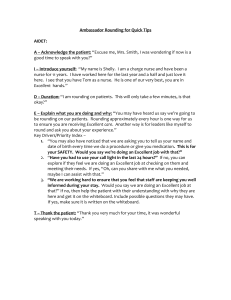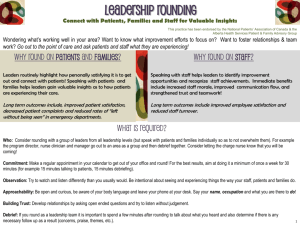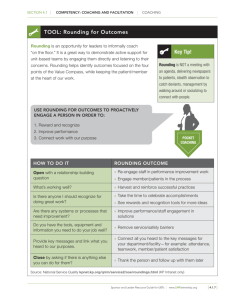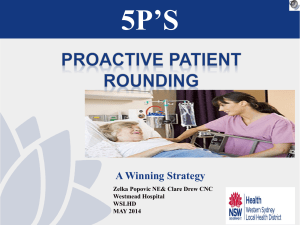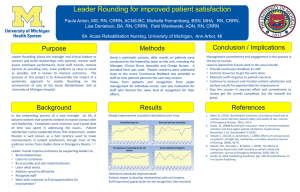Patient Satisfaction What Works
advertisement
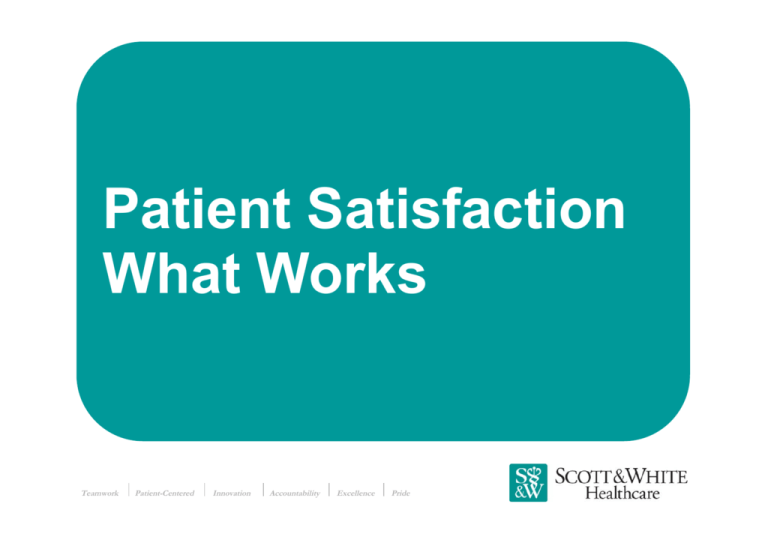
Patient Satisfaction What Works Teamwork Patient-Centered Innovation Accountability Excellence Pride Presentation Overview Impact of HCAHPS Top 5 Evidence-based Practices for Patient Satisfaction Provider Focus What is HCAHPS? HCAHPS (Hospital Consumer Assessment of Healthcare Providers & Systems) is a standardized survey developed by CMS for inpatients to evaluate their hospital experience on 10 measures of care IMPACT: Publicly reported on Hospital Compare to enable informed choice on how often adult discharged inpatients received high quality care and service Financial payment based on hospital’s performance in delivering high quality care Why HCAHPS matters to our patients? Quality of care was significantly better in hospitals that performed on HCAHPS (New England Journal of Medicine 2008;359:1921-31) – Patient’s experience is linked to great clinical care, reduced medical error and advanced performance outcomes Survey questions offer feedback on issues that impact core clinical quality – Communication of medication side effects – Managing pain well – Explaining discharge instructions in a way patients can understand Why HCAHPS matters to hospitals? Medicare & Medicaid reimbursement rates will be adjusted to at-risk amount rises to 1.25% of base DRG Payment starting October 1st 2013 Clinical Performance (45% Weight) Outcomes (Mortality) Performance (25% Weight) HCAHPS Performance (30% Weight) Hospitals must excel in performance for Operating Budget & Capital HCAHPS Survey Impact on HCAHPS Scores Nurse Communication Domain The nurse patient relationship sets the tone of the care experience and has a powerful impact on patient satisfaction since nursing spends the most time with patients Based on 2007 HCAHPS and Press Ganey Survey data, Press Ganey identified “Nurse Communication” as the factor with the greatest impact on patients’ overall ratings of their hospital experience Survey questions that focus on the nurse patient relationship drive patient ratings of their overall experience Quality of communication in nursing also has the highest impact on patients’ likelihood to recommend the hospital Source: 2010 Press Ganey Associates Top 5 Practices for Patient Satisfaction Teamwork Patient-Centered Innovation Accountability Excellence Pride Top 5 for Patient Satisfaction AIDET-Key Words Post Discharge Phone Calls Nurse Hourly Rounding Leader Rounding Strategic Goal Alignment & Accountability AIDET Acknowledge-Introduce-Duration-Explanation-Thank The five fundamentals of communication An evidence-based practice for communicating with patients, families and staff Fundamental for providing excellent customer service Framework for using “Key Words at Key Times” (i.e., we want to always answer your call light timely…) Supports “Managing Up” that takes the “I” in AIDET to the next level (i.e., “Hello, Mrs. Smith. I see this afternoon you will be going down to the radiology department. Radiology has state of the art technology and an excellent staff.) AIDET Acknowledge & Introduce The patient has the right to know who is treating them Patient’s Bill of Rights “Because greetings are one way to ensure proper identification of patients, they may well be considered a fundamental component of patient safety.” An Evidence-Based Perspective on Greetings in Medical Encounters by Gregory Makoul, PhD; Amanda Zick, MA; Marianne Green, MD. Arch Intern Med. 2007;167(11):1172-1176. “It’s all about building connection. Connection builds trust. Trust builds patient compliance. Compliance builds better health for our patients. And that’s the real picture. Why My Wife Thinks Her Doctor is so Nice by Scott Abramson, MD, Kaiser Permanente GSAA, January 2006. AIDET Explanation “Physician communication, or the lack of it, is probably one of the most important factors for patient noncompliance” 72% of patients unable to list medications they take 58% of patients unable to recite their own diagnosis Mayo Clinic Proceedings, 2005 “Most common cause of malpractice suits is failed communication with the patients and their families. Explore ways that better communication could lead to fewer malpractice claims.” Reducing Litigation Costs Through Better Patient Communication, The Physician Executive, June 2004. “Physician communication skills heavily influence patient compliance and affect clinical outcomes” Keep Your Patients Coming Back, MGMA Connexion, August 2008. Percentile Rank Source: University Medical Center in Tucson, AZ Post Discharge Phone Calls Discharge Phone Calls are a viable means to earn patient loyalty, improve quality of care, clinical outcomes and develop a reputation of excellence in the community when consistently completed “Discharge phone calls are a key tactic in the saving lives arsenal.” Words Matter by Lynne Cunningham, MHS, Spring 2009. Discharge telephone calls provide invaluable opportunities to prevent adverse events, improve quality of care, and increase patient satisfaction “Building the Value of Discharge Phone Calls and Leader Rounding”, Journal of Nursing Administration, March 2009. Post Discharge Phone Calls Evidence suggests that a post-discharge telephone call to patients may help reduce medication errors and hospital readmission Do post-discharge telephone calls to patients reduce the rate of complications? by Kelley Moulds, MD, and Kenneth Epstein, MD, MBA, The Hospitalist, August 2008. Discharge phone calls close the loop on continuity of care for the patient and family American Journal of Nursing, 2008 “You have a 90 percent chance of keeping a patient if you call within 48 hours of discharge and do something — like apologize — to make the patient’s experience better. If you wait longer than a week, you have a 10 percent chance you’ll lose 10 other patients through word of mouth”. Jap Kaplan, MD, Studer Group’s Medical Director Post Discharge Phone Calls In a study evaluating resource use in CHF patients, follow-up telephone calls significantly decreased the average number of hospital days over six months time and readmission rate at six months in the call group, as well as increased patient satisfaction Riegel B, Carlson B, Kopp Z, LePetri B, Glaser D, Unger A. Effect of a standardized nurse case-management telephone intervention on resource use in patients with chronic heart failure. Arch Intern Med. 2002 Mar 25;162(6):705-712. Source: Getwell Network White Paper: Improving Heart Failure Outcomes through Interactive Patient Care: June 2009 Top 5 for Patient Satisfaction AIDET-Key Words Post Discharge Phone Calls Nurse Hourly Rounding Nurse Hourly Rounding Rationale: Actively engages patients and families Builds Trust Reduces Anxiety Call light reduction Decreases nurse stress Decreases patient uncertainty Gardner, Glenn E., Woollett, Kaylene, Daly, Naomi, & Richardson, Bronwyn (2009). Measuring the effect of patient comfort rounds on practice environment and patient satisfaction: a pilot study. International Journal of Nursing Practice, 15(4), 287-293. Nurse Hourly Rounding Hourly rounding has a tremendous impact on patient perception and quality of care Hourly rounding effectively decreases call lights by 37.8% Decreases falls by 50% Decreases hospital-acquired decubiti by 14% Improves patient perception by 12 mean points American Journal of Nursing, September 9, 2006 Nurse Hourly Rounding Halm, Margo A., RN, PhD, CNS-BC. (2009). Hourly Rounds: What does the evidence indicate? American Journal of Critical Care, 18(6), 581-584. Nurse Hourly Rounding Deb Ricketts, RN & Reyne McEuen, RN, BSN, Positive Patient Satisfaction with Hourly Rounding Nurse Hourly Rounding Top 5 for Patient Satisfaction AIDET-Key Words Post Discharge Phone Calls Nurse Hourly Rounding Leader Rounding Leader Rounding Leader rounding for outcomes is the first key to success The point of rounding for outcomes is “to fix systems, remove barriers, model behavior, and find staff who deserve to be rewarded and recognized.” “You are also engaged in the very important process of building an emotional bank account with staff.” Quint Studer, Studer Group “When managers constantly model behavior and respond to staff concerns, they do not need to talk their employees into this change in behavior, they will walk their employees into it.” Sutter Medical Center Human Resources Director (2004 Sacramento Workplace Excellence Leader) Leader Rounding Valley Hospital Patient Experience, October 2010. Leader Rounding Benefits of Leader Rounding on Patients Increase patients satisfaction by an average 59 percentile Decrease patient complaints by 66% Reduce Emergency Department LWOT from 4.5% to 2% Baptist Leadership Institute Benefits of Leader Rounding on Staff Improved Employee Satisfaction from 10th to 75th percentile Reduce Voluntary/Non Voluntary Turnover from 11.2% to 6.1% Improve Retention from 82.5% to 87.2% Decrease Vacancy Rate from 7% to 2% Baptist Leadership Institute Leader Rounding Leader Rounding Top 5 for Patient Satisfaction AIDET-Key Words Post Discharge Phone Calls Nurse Hourly Rounding Leader Rounding Strategic Alignment and Accountability Strategic Goal Alignment and Accountability A “Must Have” for operational excellence Clearly connects the goals of the organization Reduces unnecessary work and duplication of efforts because clear expectations are set Keeps leaders focused on what is really important Hardwiring Leader Evaluations, Studer Group Health systems that fail to align their metrics with their core values are less likely to achieve outstanding results Yonek, J., Hines S., and Joshi, M., A Guide to Achieving High Performance in Multi-Hospital Health Systems, HRET, Chicago, Ill., March 2010. Relentless accountability Rush, Sandy, RN, FACHE, CHW, San Francisco, CA. “A System-Wide Approach to Moving Organizational Excellence through Accountability and the Nursing Bundle.” Strategic Goal Alignment and Accountability “The first step to creating a culture of accountability is to set the expectation for holding one's self as well as our colleagues and employees accountable for outcomes and consequences of our actions or lack thereof.” Dianne A. M. Aroh MS, RN, NEA-BC, Dianne A., Occhiuzzo MS, RN, BC, Denise, Douglas MA, RN, CNN, APN, Claudia. Blueprint for Nursing Leadership: Creating a Culture of Accountability, Nursing Administration Quarterly, July/September 2011, Volume 35 Number 3, Pages 189 - 196. 30 percent of leaders’ incentive compensation at Hopkins is based on performance on the Safety Dashboard as well as the less tangible notion of their engagement in our “culture of improvement.” Combined, these incentives build a culture of accountability for improvement. Johns Hopkins Strategic Goal Alignment and Accountability Leadership accountability at Methodist Healthcare San Antonio, TX Reduced staff turnover by 40 percent in 2009 75th percentile in patient satisfaction scores Improved patient safety scores to less than 1.12 of lost work time cases per 100 employees Meeting labor and operational budgets Studer Group Top 4 Drivers Instilling Frontline Accountability, The Advisory Board Company. Provider Focus Teamwork Patient-Centered Innovation Accountability Excellence Pride HCAHPS Survey How Do Patients Judge Quality? Did the physician listen? Did the physician express concern? Did the physician answer my questions? Did the physician care for me as a person, and not just a patient? By physicians verbal and non-verbal behavior Source: 2010 Press Ganey Associates, Inc. Interpersonal Skills “Patients place more importance on doctors’ interpersonal skills than their medical judgment or experience, and doctors failing in these areas are the overwhelming factor that drives patients to switch” Wall Street Journal, September 2004 Importance of Physician Communication “20% of all Medicare patients discharged from hospitals were readmitted within 30-days and 34% within 90-days. The Joint Commission and others rightly believe that inadequate communication between physicians, as well as between physicians and patients, is a major contributing factor.” New England Journal of Medicine 2009 HCAHPS Doctor Communication Domain Doctor Communication Domain 1 of 8 Domains on HCAHPS Survey Comprised of 3 Survey Questions: During this hospital stay, how often did doctors treat you with courtesy and respect? During this hospital stay, how often did doctors listen carefully to you? During this hospital stay, how often did doctors explain things in a way you could understand? Greatest Impact on Doctor Communication Doctor Communication Domain Improvement in Doctors’ Listening Skills will most strongly impact the Doctor Communication Score Respect Other Explain 1% 5% 5% Listen 89% Source: 2011 Press Ganey Associates, Inc. Provider Communication QUESTION During this hospital stay, how often did doctors treat you with courtesy and respect? RESPONSE SCALE Always, Usually, Sometimes, Never SCRIPTING “As a courtesy and respect to our patients, we knock before entry”. ACTIONS & BEHAVIORS Make eye contact with patient. Acknowledge all in room. The first impression is established here. Employ a warm, friendly and reassuring manner. Introduce yourself to the patient, your role in the patient’s care and the experience that you bring. Greet the patient by name and shake hands if possible. Communicate your awareness of relevant clinical data to the patient as this impacts patient’s perception of care. Sit whenever possible. Ask permission to begin an exam or assessment. Empathy Patients whose physicians were rated as more empathetic had higher rates of high satisfaction than patients whose physicians were less empathetic (29% vs 11%; P=.004) Patients whose physicians made any reflective statements had higher rates of high autonomy support than those whose physicians did not (46% vs 30%; P=.006) Patient-physician communication is a central component of high-quality care Pollak, K, PhD. JAFM. 2011: 24(6): 665-672. Provider Communication QUESTION During this hospital stay, how often did doctors listen carefully to you? RESPONSE SCALE Always, Usually, Sometimes, Never SCRIPTING, ACTIONS & BEHAVIORS Use open-ended questions. “Tell me about your pain.” Follow the 2-minute rule. Allow the patient to talk for at least 2-minutes uninterrupted while maintaining eye contact for 80% of time and listening (2-minutes sitting at the bedside is perceived better than 10-minutes standing in the doorway) “I want to make sure I heard you correctly…” “I care about how you are doing…” “Let me see if I understand…” “Does that sound reasonable to you?” Convey sincere empathy regarding pain. “I’m sorry this has been your experience.” “I’m sorry that you have experienced the severe pain as this will no…” Patient’s Listening A patient’s listening is motivated by a universal need: The need for compassion The need to be heard The need to be recognized From a tone of voice or acknowledgment, the patient can readily hear if the white coat standing in front of him/her is someone who can care enough to listen. Shannon, M. The Permanente Journal: Spring 2011; Vol. 15, 2. Provider Communication QUESTION During this hospital stay, how often did doctors explain things in a way you could understand? RESPONSE SCALE Always, Usually, Sometimes, Never SCRIPTING, ACTIONS & BEHAVIORS Explain the patient’s diagnosis, tests and care in general in clear, simplistic, non-technical terms that is easier to understand. “Let me explain your diagnosis to you.” “Let me explain the tests that I am going to ask for you to receive and what will happen next.” (Explain what you will do & why before doing it) “Let me explain what to look for…” “Let me explain what you need to do…” “Let me explain why you are taking this medication, the generic name and the potential side effects.” “Let me explain what to expect after surgery…” Importance of Communication “Physician communication or the lack of it, is probably one of the most important factors for patient noncompliance. Mayo Clinic found: 72% of patients were unable to list medications that they take 58% of patients were unable to recite their own diagnosis” Mayo Clinic Proceedings 2005 Explanation “Simple choices in words, information depth, speech patterns, body position, and facial expression can greatly affect the quality of one-on-one communication between the patient and physician.” Travaline, J.M. MD, Ruchinskas, R., PsyD., D’Alzonzo Jr, G. JAOA: 1, 2005; Vol. 105, No 1:13-18. Focus on the “A & I” to show Courtesy & Respect by ALL Physicians, Nurses, Students & Support Staff Focus on the “E” to Explain Medications, Diagnosis & Information. A I D E T Acknowledge - Entry to All Patient Rooms (Make eye contact & smile!) •Acknowledge everyone in the room •Address the patient by name •Make the patient your focus Introduction to Patients and Family •Introduce yourself “Hello, Mr. Smith, I am ___, your ___ (surgeon…).” •Statement of experience •Sit down if possible at patient’s level Duration - Communication on Duration •“Mr. Adams, we will have the results of your lab tests and x-rays this afternoon. I will be back this afternoon to discuss our treatment options.” Explanation •Carefully listen to the patient’s story uninterrupted (2 minutes at least) •Use language the patient can understand when describing the treatment plan (e.g. “We’ll run a CK-MB to determine AMI” vs. “We’ll run some blood tests to determine if you’ve suffered a heart attack.”) Thank - When leaving a room, make eye contact and ask: •“Do you have any questions?” •“Is there anything else I can do for you?” •“Thank you for allowing me to care for you.”
